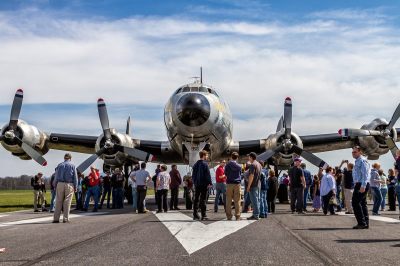Although the designation ‘Air Force One’ is now commonly known to refer to the airplane used by the President of the United States, it wasn’t until Eisenhower that the US President would make significant use of a dedicated airplane. He would have a Lockheed VC-121A kitted out to act as his office as commander-in-chief. Called the Columbine II after the Colorado columbine flower, it served a crucial role during the Korean War and would result the coining of the ‘Air Force One’ designation following a near-disaster in 1954.
This involved a mix-up between Eastern Air Lines 8610 and Air Force 8610 (the VC-121A). After the Columbine II was replaced with a VC-121E model (Columbine III), the Columbine II was mistakenly sold to a private owner, and got pretty close to being scrapped.

Although nobody is really sure how this mistake happened, it resulted in the private owner stripping the airplane for parts to keep other Lockheed C-121s and compatible airplanes flying. Shortly before scrapping the airplane, he received a call from the Smithsonian Institution, informing him that this particular airplane was Eisenhower’s first presidential airplane and the first ever Air Force One. This led to him instead fixing up the airplane and trying to sell it off. Ultimately the CEO of the airplane maintenance company Dynamic Aviation, [Karl D. Stoltzfus] bought the partially restored airplane after it had spent another few years baking in the unrelenting sun.
Although in a sorry state at this point, [Stoltzfus] put a team led by mechanic [Brian Miklos] to work who got the airplane in a flying condition by 2016 after a year of work, so that they could fly the airplane over to Dynamic Aviation facilities for a complete restoration. At this point the ‘nuts and bolts’ restoration is mostly complete after a lot of improvisation and manufacturing of parts for the 80 year old airplane, with restoration of the Eisenhower-era interior and exterior now in progress. This should take another few years and another $12 million or so, but would result in a fully restored and flight-worthy Columbine II, exactly as it would have looked in 1953, plus a few modern-day safety upgrades.
Although [Stoltzfus] recently passed away unexpectedly before being able to see the final result, his legacy will live on in the restored airplane, which will after so many years be able to meet up again with the Columbine III, which is on display at the National Museum of the USAF.















No link to the story of the near accident?
https://www.popularmechanics.com/flight/a20122/how-the-very-first-air-force-one-was-saved/
Also it appears a VC 121E is just a 121A converted into a presidential transport. So Columbine II and III are both the same. According to the PopSci article.
That is factually incorrect. Columbine II is a VC-121A (V for VIP) and Columbine III a VC-121E. They’re two distinct airframes. The PopSci article seems to be getting that and a range of other details very wrong.
“Mistakenly sold” as one does.
The Connie — the finest 3-engine aircraft ever built :)
Not the Ford Tri-Motor?
I guess I’m not getting the joke…
The joke is that the Connie was well known for losing an engine in flight on a regular basis.
Thanks!
Quick question… Why is something like allowed to be owned privately?
Private stewardship is one thing.
Private OWNERSHIP of something with historical public significance is something else entirely.
Did you know that the Smithsonian Institute can sell ANYTHING donated to it to anyone?
(Yes, even if the donation contract stipulates that the donation can not be resold!)
I’m really torn on this one.
While history is important and all that, who is paying $12M for this? I hope private aviation enthusiasts. Because the public, if paying for it, would not really be able to benefit. And an aircraft can definitely be in not-flight worthy status but activate and amazing to look at in a museum where everyone can look at it and say “neato” for way less money. Flying an 80yr old airframe is also becoming a more questionable proposition as well.
I take no issue with selling this off to private person either. Even for scrap. Should every single car a present has we’ve read be preserved for … history? Where does it stop?
Wow autocorrect really let me down there.
… car that an president has ever had be preserved for…
Sorry for double post.
This is the only presidential aircraft ever sold. We’ve kept and restored all of them. Why would we suddenly decide we didn’t care about the very first one?
And it is being funded by private parties. It’s also a community project in which refabrication of 70-year-old parts is being presented as a challenge to young STEM engineers, so the benefits go far beyond amusing the public in a museum.
Very few of these things get preserved – an incredible amount of stuff that most people would consider somewhat interesting, significant, or at least collectible gets thrown away or scrapped. Just look at how few original planes survive from WW2 given how many were manufactured. Or the fact we now have no airworthy Vulcans or Concordes.
Also it’s mostly well-off folks who are aviation or history enthusiasts that donate money to preserve this stuff before you get too indignant about the money – same with a lot of museums and galleries. Peter Jackson for example is a plane nut and has poured a load of money (and I assume a lot of his private collection) into his “local” museum in NZ.